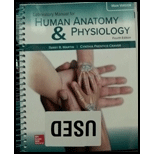
Laboratory Manual For Human Anatomy & Physiology
4th Edition
ISBN: 9781260159080
Author: Martin, Terry R., Prentice-craver, Cynthia
Publisher: Mcgraw-hill Education,
expand_more
expand_more
format_list_bulleted
Textbook Question
Chapter 36, Problem 8PL
A convex lens can be used to correct hyperopia.
a. True ________
b. False ______
Expert Solution & Answer
Want to see the full answer?
Check out a sample textbook solution
Students have asked these similar questions
Hypermetropia can be corrected by the use of convex lens. Comment.
please answer asap
what will happen if an eyeglasses has:
a. two converging lens (explain)
b. two diverging lens (explain)
c. both converging and diverging lens (explain)
P.S. This is not a multiple choice question thank You
Chapter 36 Solutions
Laboratory Manual For Human Anatomy & Physiology
Ch. 36 - As a person ages, the elasticity of the lens a....Ch. 36 - Visual acuity is measured using a a. metric ruler....Ch. 36 - Color blindness is a characteristic in of males a....Ch. 36 - The blind spot is located at the of the eye. a....Ch. 36 - Astigmatism results from a defect in the a....Ch. 36 - Only males can inherit the color blindness...Ch. 36 - Nearsightedness is also called myopia. a. True...Ch. 36 - A convex lens can be used to correct hyperopia. a....Ch. 36 - Explain why small objects e not lost from our...Ch. 36 - Complete the following a. What is meant by 20/70...
Knowledge Booster
Learn more about
Need a deep-dive on the concept behind this application? Look no further. Learn more about this topic, biology and related others by exploring similar questions and additional content below.Similar questions
- Blind-spot results: a. Right eye distance _______________________b. Left eye distance _______________________arrow_forwardA patient’s visual acuity is assessed as 20/40 in both eyesusing the Snellen chart. The nurse interprets this finding as:a. The patient can see twice as well as normal.b. The patient has double vision.c. The patient has less than normal vision.d. The patient has normal vision.arrow_forwardThe coarse and fine focus knobs adjust the distance betweena. the objective and ocular lenses.b. the ocular lenses.c. the ocular lenses and your eyes.d. the stage and the condenser lens.e. the stage and the objective lens.arrow_forward
- Pupillary dilation is caused by the contraction of the circular muscles of the eye. a TRUE b FALSEarrow_forwardThe most suitable angle for the cone of vision for drawing perspective is 60° 45° 30° 15°arrow_forwardTo alter the amount of light coming through the stage someone should adjust the: Group of answer choices 1. eye pieces 2. coarse focus 3. objective 4. iris diaphragm 5. fine focusarrow_forward
- Provide significant recordings/finding that can be observed on the said structures that can be viewed under the slitlamp externally. eyelid eyelashes bulbar conjunctiva cornea crystalline lensarrow_forwardMatch the objective lenses with permissible behaviors: For some rows you’ll list more than 1 objective lens Adjust focus using coarse adjustment knob Adjust focus using the fine adjustment knob Use oil to connect the slide to the lens Adjust the light using the condenser and/or iris diaphragm A. 4X B. 10X C. 40X D. 100Xarrow_forwardOIL EMERSION IS REQUIRED FOR which lensarrow_forward
- Provide significant recordings/finding that can be observed on the said structures that can be viewed under the slitlamp externally. eyelash eyelid palpebral conjunctiva cornea crystalline lensarrow_forwardA 56-year-old female had been experiencing some difficulty reading books and newspapers. In order to retain the text in focus while reading, she kept the text at an arm’s length away. The woman is exhibiting: a. delusion b. presbycusis c. presbyopia d. emmetropia e. cataractarrow_forwardWhen reading, a person with astigmatism sees some lines in sharp focus while others appear blurred. Astigmatism is caused by the Select one: a. inability of the iris to contract or dilate b. lens becoming cloudy and rigid c. number of cones on some parts of the retina being deficient O d. curvature of the cornea or lens not being symmetricalarrow_forward
arrow_back_ios
SEE MORE QUESTIONS
arrow_forward_ios
Recommended textbooks for you
 Medical Terminology for Health Professions, Spira...Health & NutritionISBN:9781305634350Author:Ann Ehrlich, Carol L. Schroeder, Laura Ehrlich, Katrina A. SchroederPublisher:Cengage Learning
Medical Terminology for Health Professions, Spira...Health & NutritionISBN:9781305634350Author:Ann Ehrlich, Carol L. Schroeder, Laura Ehrlich, Katrina A. SchroederPublisher:Cengage Learning Comprehensive Medical Assisting: Administrative a...NursingISBN:9781305964792Author:Wilburta Q. Lindh, Carol D. Tamparo, Barbara M. Dahl, Julie Morris, Cindy CorreaPublisher:Cengage Learning
Comprehensive Medical Assisting: Administrative a...NursingISBN:9781305964792Author:Wilburta Q. Lindh, Carol D. Tamparo, Barbara M. Dahl, Julie Morris, Cindy CorreaPublisher:Cengage Learning



Medical Terminology for Health Professions, Spira...
Health & Nutrition
ISBN:9781305634350
Author:Ann Ehrlich, Carol L. Schroeder, Laura Ehrlich, Katrina A. Schroeder
Publisher:Cengage Learning



Comprehensive Medical Assisting: Administrative a...
Nursing
ISBN:9781305964792
Author:Wilburta Q. Lindh, Carol D. Tamparo, Barbara M. Dahl, Julie Morris, Cindy Correa
Publisher:Cengage Learning
Visual Perception – How It Works; Author: simpleshow foundation;https://www.youtube.com/watch?v=DU3IiqUWGcU;License: Standard youtube license